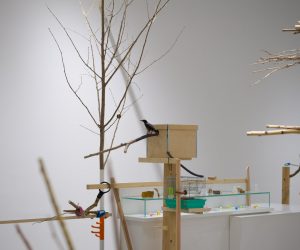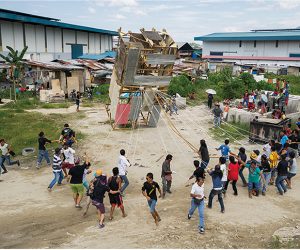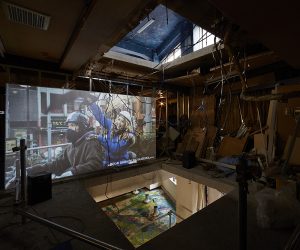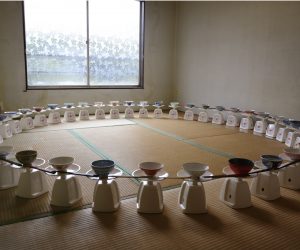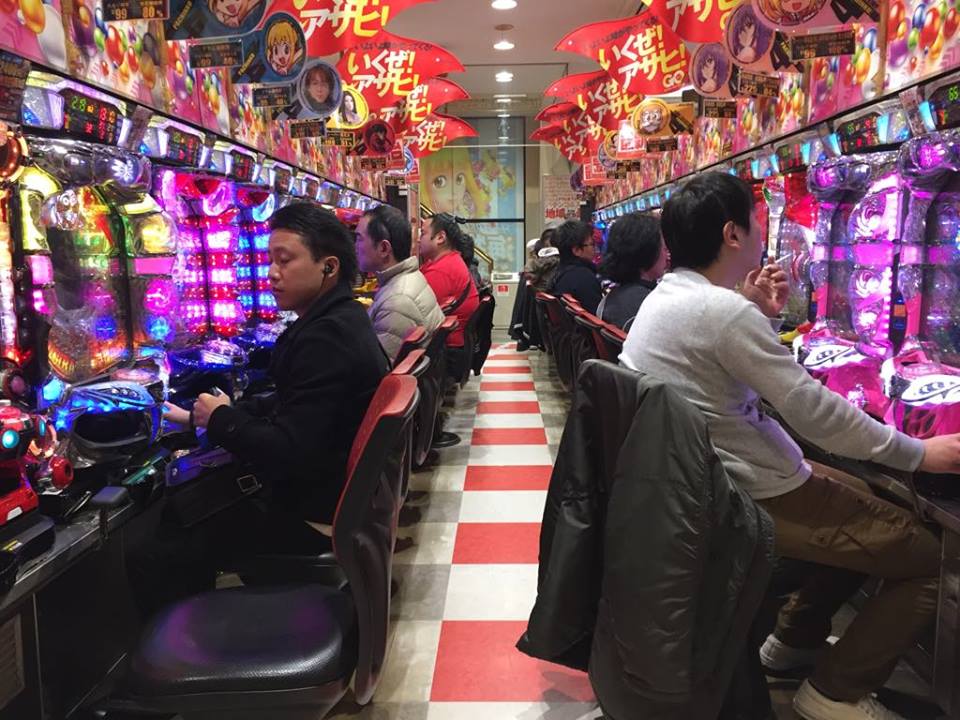
Practices as an Intersection in a Fragile Environment #5_Tokyo
–
Supereality, SuperMa
È un dato di fatto che i confini dell’arte si sono progressivamente allargati in uno spazio plurale e trasversale in cui, attraverso altre discipline, l’arte interroga se stessa e il dominio del sociale (Guattari). Ancor di più lo è per quelle pratiche che guardano allo spazio pubblico come luogo di indagine privilegiato. Lo spazio pubblico è infatti per sua stessa natura uno spazio frammentato (Sheikh), uno spazio di soggettività diverse, un’arena, un campo di battaglia (Bourdieu; Haake). In questo quadro di sconfinamento, l’arte cerca con il suo linguaggio di dare una risposta all’impotenza, alla precarietà e alla solitudine (Berardi “Bifo) prodotti dal moderno sistema neo-liberale. Se dunque il capitalismo produce soggetti passivi con poca capacità di agire e poco emancipati, l’arte, attraverso pratiche orizzontali e strategie di partecipazione, tenta invece di attivare processi di ri-umanizzazione. La partecipazione sta diventando, in un contesto di pratiche che guardano e si interfacciano con la realtà, sempre più importante come progetto (Debord) e il corpo torna quindi a giocare un ruolo centrale sia rispetto all’attivazione delle pratiche artistiche, che in seno a contesti più strettamente sociali. L’antropologo italiano Franco La Cecla (Contro l’urbanistica) parla infatti di una ripresa politica del rapporto tra corpi urbani e spazi urbani che si fa nell’esperienza diretta. Allo stesso modo le pratiche di partecipazione tentano di ripristinare e realizzare uno spazio collettivo, condiviso, interrogandosi sui sistemi esistenti e cercando di scardinare condizioni prestabilite attraverso nuovi linguaggi e strategie di intromissione nello spazio pubblico. Strategie che prevedono, o aspirano, ad una crescita della coscienza attraverso il pensiero critico o, come detto, un coinvolgimento fisico più diretto all’interno di un’azione simbolica. In questo senso, bisogna essere onesti verso lo spettatore che diventa allo stesso tempo produttore (a volte) e performer. Vivendo dunque al limite della contraddizione tra una partecipazione intellettuale, quella dell’artista o del curatore, tesa ad una proiezione nella situazione, e i cittadini stessi, che giornalmente si confrontano con i problemi della vita reale, bisogna riconoscere la presenza di una discrepanza tra chi produce progetti, seppure con intenzioni autentiche alla base, e chi vi partecipa. L’approccio artistico o curatoriale non può quindi che essere rappresentativo di uno stato di cose e deve, fin dall’inizio chiarire gli obiettivi. Sta poi a chi partecipa capire come percorrere e affrontare il cammino, come e quanto mettersi in gioco. Queste pratiche o strategie vanno infatti verificate e ri-negoziate di volta in volta all’interno di contesti specifici. L’orizzontalità non è mai, infatti, il fine, resta piuttosto un’intenzione, uno strumento capace di stimolare continui interrogativi su come un altro modi di organizzare sia possibile inventando nuove istituzioni del comune (Lorey). Il lavoro dei quattro artisti coinvolti innescano tutti scenari atti a creare spazi di partecipazione critica o fisica costruendo ambienti transitori, flessibili e in continua evoluzione al limite del rapporto tra utopia e distopia quasi una sorta di pre e post (Tetsuro Kano); piattaforme di partecipazione diretta che trovano nel disastro di Fukushima (marzo 2011) un punto di svolta (Tsubasa Kato); o che incitano attraverso un linguaggio neo-dada ad un cambiamento sociale molto forte interrogandosi su quali risposte possa generare l’arte (Chim↑Pom); o luoghi fortemente simbolici capaci di determinare dispositivi simbolici o generare azioni che si interrogano sulla relazione e i confini tra corpo e spazio generando processi di partecipazione critica (Ishu Han).
___
It is a fact that the boundaries of art have progressively broadened into a plural and transversal space in which, through other disciplines, art questions itself and the realm of the Social (Guattari). Even more for those practices that look to the public space as a place of privileged investigation. The public space is in fact by its very nature a fragmented space (Sheikh), a space of different subjectivities, an arena, a battleground (Bordieu/Hacke). In this context of trespassing, art seeks with its language to give an answer to the impotence, precariousness, and loneliness (Berardi “Bifo”) produced by the modern neo-liberal system. If therefore, capitalism produces passive subjects with little capacity to act and not emancipated, the art, through horizontal practices and strategies of participation, tries instead to activate processes of re-humanization. Participation is becoming, in a context of practices that look and intermingle with reality, more and more important as a project (Debord) and the body then returns to play a key role both in relation to the activation of artistic practices and in a more strictly social context. The Italian anthropologist Franco La Cecla (Contro l’urbanistica) claims, in fact, a political upswing of the relationship between urban bodies and urban spaces that can only be done through a direct experience. In the same way, the practices of participation attempt to restore and realize a collective/shared space, by questioning the existing systems and trying to undermine predetermined conditions through new languages and strategies of interference in the public space. Strategies that foresee, or aspire to, a growth of consciousness through critical thinking or, as mentioned before, a more direct physical involvement in a symbolic action. In this sense, it is crucial, to be honest towards the spectator who becomes at the same time producer (sometimes) and performer. Living thus at the cusp of the contradiction between an intellectual participation, that of the artist or the curator, aimed at a projection in the situation, and the citizens themselves, who daily confront the problems of real life, one must recognize the presence of a discrepancy between those who produce projects, albeit with genuine intentions at the base, and who participates. The artistic or curatorial approach cannot, therefore, be representative of a state of facts and must, from the very beginning, clarify the objectives. It is then who participates to understand how and if being involved in the path. These practices or strategies must, in fact, be verified and re-negotiated every time within specific contexts. Horizontality is never, in fact, the aim, it remains rather an intention, a tool able to continuously question about how another way of organizing would be possible by inventing new institutions of the commune (Lorey). The works by the four artists involved trigger scenarios that create spaces for critical or physical participation building transient, flexible (ongoing) environments at the limit of the relationship between Utopia and Dystopia almost a sort of pre and post (Tetsuro Kano); platforms of direct participation that found in the Fukushima disaster (March 2011) a turning point (Tsubasa Kato); or platforms that incite through a neo-dada language to a very strong social change by questioning which answers could be created by the art (Chim ↑ Pom); or, finally, strongly symbolic places capable of determining symbolic devices or generating actions that question the relationship and the borders between body and space, nurturing processes of critical participation (Ishu Han). Questo di Tokyo, che va sotto il titolo di Supereality, SuperMa, è dunque un capitolo parziale – altri artisti oltre ai quattro coinvolti qui, il cui lavoro si concentra su questo tema, e che al momento vivono non vivono in Giappone, saranno approfonditi successivamente – che sarà finalizzato con la presentazione di quattro lavori. Questi lavori vanno principalmente intesi come possibili chiavi d’accesso ad un tema così ampio come quello della partecipazione.
___
This of Tokyo, that goes under the title Supereality, SuperMa, is thus a partial chapter – other artists apart of the four involved here, which work investigates this field, live now abroad but will be scrutinized afterward – that has been finalized with the presentation of four works. These works are mainly intended to be possible key access to such as broaden topic as the participation.
Japanese notion of “Ma (間)”: “Ma” has appeared every aspect of Japanese life and culture and is something the Japanese sense daily. For example, in arts, “Ma” can be translated into English as pause, break or simply silence in music and performance, as distance and “in-between” in architecture and garden design, and as margin or blank space in painting. Therefore, “Ma” has a wide range of meanings so that it is so difficult to define itself.Interesting enough, I would like to introduce Chinese characters of four Japanese terms, Space: Ku(空)-kan(間), Time: Ji(時)-kan(間), Human beings: Nin(人)-gen(間) and Society or Public: Se(世)-ken(間), the character of“Ma (間)” are included for all these words.Here, I focus on the terms nin-gen and se-ken meaning human being and the society or public in relation to the concept of“Ma”. The character for “nin” means human and the character for “se (yo)” means world and both characters are combined with the character of Ma.In this sense,“Ma”can be meant“in-between space” and Japanese see own their identities between people in society or the public. In other words, it tells the Japanese needs“in-between space” to find self through relations.
http://performativepractices.blogspot.jp/p/practices-as-intersection-in-fragile_13.html
http://www.tokyoartsandspace.jp/english/archive/2018/02/r0309.shtml
https://www.facebook.com/events/1912700042137902/
http://atpdiary.com/practices-as-an-intersection-in-a-fragile-environment-intervista-a-claudio-zecchi/
